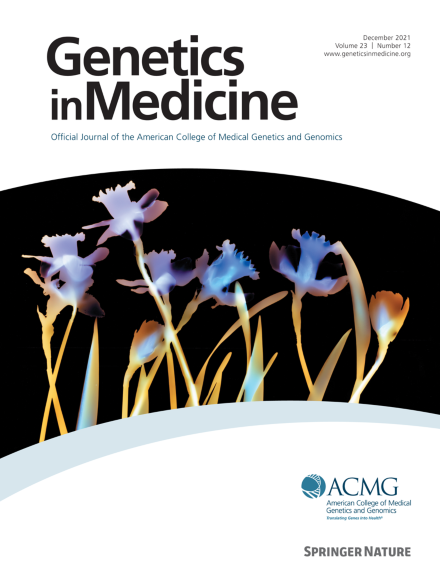Clinical signatures of SYNGAP1-related disorders through data integration
IF 6.6
1区 医学
Q1 GENETICS & HEREDITY
引用次数: 0
Abstract
Purpose
SYNGAP1 is a genetic neurodevelopmental disorder characterized by generalized epilepsy, autism, and intellectual disability. Despite a comparatively high prevalence, the longitudinal landscape remains relatively unexplored, and complete characterization is essential for clinical trial readiness.
Methods
We combined electronic medical record data (n = 158) with insurance claims data (n = 246) to evaluate longitudinal progression of symptoms.
Results
Phenotypes associated with SYNGAP1 included behavioral abnormalities (odds ratio [OR]: 12.35, 95% CI: 9.21-16.78), generalized-onset seizures (OR: 1.56, 95% CI: 1.20-2.02), autism (OR: 12.23, 95% CI: 9.29-16.24), and a developmental profile with prominent deficits in verbal skill acquisition. Several clinical features showed distinct age-related patterns, such as a more than 5-fold risk of autistic behavior emerging between 27 and 30 months. Generalized-onset seizures were significantly increased (OR: 4.05, 95% CI: 2.02-7.59) after 3 years of age and persisted over time. Valproic acid and clobazam were commonly used for epilepsy treatment, whereas risperidone, aripiprazole, and guanfacine were commonly used for behavior management. Valproate and lamotrigine were more effective at reducing seizure frequencies or maintaining seizure freedom than other antiseizure medications.
Conclusion
We delineated the seizure, developmental, and behavioral trajectories in SYNGAP1-related disorders, to improve diagnosis, prognosis, and clinical care, and facilitating clinical trial readiness.
通过数据整合研究syngap1相关疾病的临床特征
目的:SYNGAP1是一种以全身性癫痫、自闭症和智力残疾为特征的遗传性神经发育障碍。尽管患病率相对较高,但纵向景观仍然相对未被探索,完整的表征对于临床试验准备是必不可少的。方法:我们结合电子病历资料(n=158)和保险索赔资料(n=246)来评估症状的纵向进展。结果:与SYNGAP1相关的表型包括行为异常(比值比(OR) 12.35, 95% CI 9.21-16.78),全发性癫痫(OR 1.56, CI 1.20-2.02),自闭症(OR 12.23, CI 9.29-16.24),以及语言技能习得显著缺陷的发育特征。一些临床特征显示出明显的年龄相关模式,例如在27到30个月之间出现自闭症行为的风险超过5倍。3岁后,全发性癫痫发作显著增加(OR 4.05, CI 2.02-7.59),并随时间持续。癫痫治疗常用丙戊酸和氯巴唑,行为管理常用利培酮、阿立哌唑和胍法辛。丙戊酸钠和拉莫三嗪在减少癫痫发作频率或维持癫痫发作自由方面比其他抗癫痫药物更有效。结论:我们描述了syngap1相关疾病的发作、发育和行为轨迹,以改善诊断、预后和临床护理,并促进临床试验准备。
本文章由计算机程序翻译,如有差异,请以英文原文为准。
求助全文
约1分钟内获得全文
求助全文
来源期刊

Genetics in Medicine
医学-遗传学
CiteScore
15.20
自引率
6.80%
发文量
857
审稿时长
1.3 weeks
期刊介绍:
Genetics in Medicine (GIM) is the official journal of the American College of Medical Genetics and Genomics. The journal''s mission is to enhance the knowledge, understanding, and practice of medical genetics and genomics through publications in clinical and laboratory genetics and genomics, including ethical, legal, and social issues as well as public health.
GIM encourages research that combats racism, includes diverse populations and is written by authors from diverse and underrepresented backgrounds.
 求助内容:
求助内容: 应助结果提醒方式:
应助结果提醒方式:


